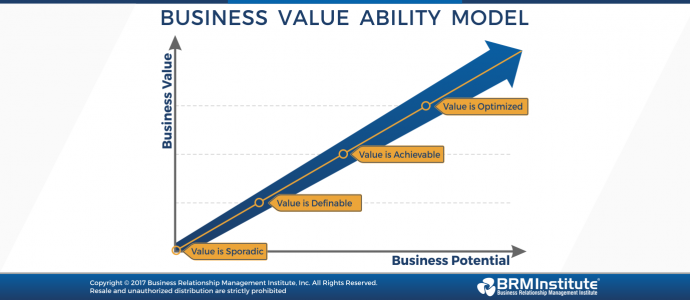BRM Capability
A business relationship management capability is everything it takes, both visible and invisible, to nurture relationships in an organization. Examples of visible components are meetings, artifacts, and professional development, while examples of invisible components are knowledge learned, experience gained, trust, and confidence-building. Used effectively, these components build the endless reserve of energy necessary to evolve culture, build partnerships, drive value, and satisfy purpose.
The business relationship management capability facilitates culture advancement, driving it to one of trust, creativity, innovation, authenticity, and shared ownership across the organization. A mature business relationship management capability converges cross-functional teams to create holistic strategies that deliver organizational value and meaningful results.
Click here to learn more on: BRM Capability Defined | BRM Capability Success
Is Your Business Function Positioned to Share Ownership and Become a Strategic Partner?
Learn how a BRM team can play a major role in helping your department transition to being a trusted strategic partner with business.
Shifting Your Mindset to Ensure Business Value
When it comes to realizing value, a good place to start is changing the way business approaches project delivery.
Bringing Teams Together in Times of Discord
Considering the complexities that teams face in the modern workplace, it’s common to experience discord from time to time. The challenge lies in turning discord into an advantage—a launch pad for improved team cohesion.
From Cost to Value: Changing the IT Conversation, Part 2
Let’s assume you’ve already made your case for the value of IT within corporate strategy. It’s time to think about IT transformation from a project perspective: measuring value and communicating it back out.
Influencing Without Power: A BRM Success Story
How can BRMs influence without direct reporting lines or structural power? It takes trust over manipulation, and above all else, you have to have presence.
BRMs: We Can Do Anything, but Not Everything
Few things remain constant in the business environment, with the exception of resources and capital. However, these things aren’t necessarily unique to IT—so why is there frustration when IT fails to do everything asked of them, and how do we challenge this?
From Cost to Value: Changing the IT Conversation, Part 1
BRMs have much to offer when it comes to strategy, but in order to get the word out to business partners, the conversation has to change from cost centers to value centers, a culture of output needs to turn into a culture of creativity, and IT needs to think like marketing.
Ensuring Business Value Through BRM
As BRM professionals, we are responsible for helping our organizations deliver business value. But what does business value really mean, and what role can the BRM play in achieving it?
Convergence Culture is Key to Business Success
Convergence culture allows organizations to be more efficient when meeting demands, building strategy, and sharing ownership of results.
Your BRM Capability’s Success Hinges on the Support of Leadership
When it comes to articulating the value of BRM in your organization, it’s not how well you do it—it’s how well an executive can explain it when you’re not in the room.
IT Evolution: The Path to IT Maturity
IT is in a state of flux, which probably isn’t news to you. Business has grown progressively more technology-centric during the last few years, causing IT to shift from the periphery to the heart of the business. So what’s next?
The Meaning of Achieving ITSM Excellence
If it’s the responsibility of IT professionals to be fluent in the languages of both business and IT, why aren’t more business-IT professionals aware of ITSM elements?
The Three Kinds of BRM and Why You Need Them All
In this digital age, we live in a world full of acronyms that can mean different things to different people. What do the letters ‘BRM’ bring to mind?
The BRM’s Role in Moving IT to a Converged Strategic Partner
Moving from being seen as a service provider to being a converged strategic partner is a team effort between the BRM and the business function.
Evolving Into a Business Leader: How to Earn a Seat at the Strategic Table
In order to earn a seat at the strategic table, BRMs must be ready to meet the current challenges the business is facing in the wake of digital disruption. Learn how challenging the status quo can revolutionize your business partner relationship.
New to BRM? The Essential Tips, Tricks, and Tools You Should Know
Starting a new BRM function can be a daunting—though exciting—prospect. If you’re a new BRM, the first question you may be asking yourself is, “Where do I even start?”
Relationships That Matter to the BRM
It’s no secret that the “R” in BRM stands for “relationship”—but relationships between whom? Learn about the relationships that should matter the most to a successful BRM.
CEOs, Do You Know Your Business Value Ability?
CEOs, learn how much business value ability your BRM capability has—and learn what it could potentially be if your BRM capability is expanded upon.

